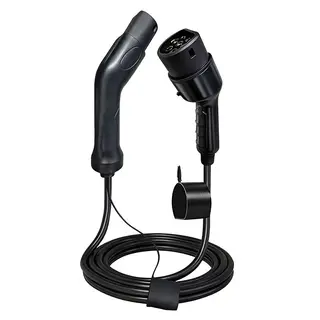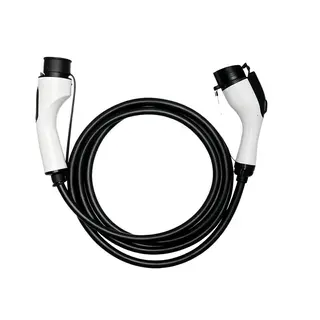With the popularity of electric vehicles, the demand for charging facilities is also increasing. As an efficient and convenient charging solution, wall-mounted EV chargers have been favored by many vehicle owners. This article provides a detailed introduction to the features, advantages, installation considerations, and selection of suitable wall-mounted EV chargers, helping you better understand this smart charging device.
The core function of a wall-mounted EV charger is to provide safe and efficient charging services for electric vehicles. During the charging process, communication and control between the charger and the vehicle are required. This communication is mainly realized through signal interaction between the control unit inside the charger and the vehicle's onboard charger.
The control unit is the "brain" of the EV charger. It is responsible for monitoring various parameters during the charging process, such as current, voltage, and temperature. Based on these parameters, the control unit can adjust the charging strategy in real time to ensure the safety and efficiency of the charging process. For example, when abnormal current or voltage is detected, the control unit automatically adjusts the charging power to prevent damage to the vehicle battery.
In addition, wall-mounted EV chargers are equipped with human-machine interfaces, such as touch screens, allowing users to set charging modes, check charging status, and record charging data. Some high-end chargers also support connectivity with smartphones and other devices, enabling users to remotely control the charging process and monitor the charging status anytime, anywhere.
Safety is the primary consideration for charging equipment. Wall-mounted EV chargers fully consider various safety protection measures during design and manufacturing to ensure the safety of users and property.
The EV charger has a built-in overload protection device. When excessive current occurs during charging, the circuit is automatically cut off to prevent safety accidents such as fire or equipment damage caused by overload. This protection mechanism can effectively prevent dangers caused by equipment failure or operational errors.
The EV charger is also equipped with leakage protection. Once leakage is detected, the system quickly cuts off the power supply to ensure user safety. The leakage protection device is an important component of the EV charger's safety measures, effectively preventing electric shock accidents.
Considering that EV chargers may be installed outdoors or near outdoor areas, lightning protection is also essential. Wall-mounted EV chargers usually feature lightning protection designs, which can effectively prevent damage to the charger and vehicles during thunderstorms. This design ensures safe operation of the equipment under harsh weather conditions.
When installing wall-mounted EV chargers, multiple factors need to be considered to ensure safe, stable, and efficient operation.
Wall-mounted EV chargers are typically installed in underground or semi-underground garages to make full use of space and facilitate management and use. When selecting a specific location, priority should be given to walls near parking spaces, dry and ventilated areas, and locations convenient for wiring. The wall for installation should have a certain load-bearing capacity, and the wall thickness should not be less than the specified minimum (e.g., 200mm) to ensure stability and safety. If the wall is made of lightweight materials such as hollow bricks or gypsum boards, a metal backing plate may need to be added to enhance load-bearing capacity.
The height of the charger's centerline from the ground should be moderate, generally recommended at about 1.5 meters, which facilitates plugging and unplugging the charging gun while preventing children from easily touching it. Wall-mounted EV chargers built at the same time should be centrally located to facilitate management and maintenance. At the same time, fire-resistant walls and fire doors should be used for isolation to improve safety.
During planning, electrical safety requirements should be fully considered. For example, the low-voltage circuit breaker supplying power to the charging equipment should have short-circuit protection and residual current protection functions to ensure that the power can be cut off promptly in abnormal situations. For wiring, routes should be concealed and easy to maintain. Wires should be protected with conduits and should not be exposed to environments where they are easily damaged. Wire specifications should also meet the power requirements of the EV charger to ensure charging efficiency and safety.
To facilitate user identification and use, it is recommended to set up obvious signage or indicator lights near the EV charger to indicate the location and usage status of the facility. Clear signage can improve user experience and reduce confusion during use.
The design of wall-mounted EV chargers generally follows the principles of compactness, simplicity, and modernity. This design is not only aesthetically pleasing but also effectively reduces visual clutter. The housing is often made of high-quality alloy materials such as PC/ABS, ensuring the EV charger's sturdiness and durability while also being lightweight for easy handling and installation.
Additionally, the color and style of wall-mounted EV chargers can support personalized customization services to suit different architectural environments. For example, colors can be selected to coordinate with the surrounding environment or customized according to user preferences. This not only enhances aesthetics but also helps the charger better blend into its environment.
One of the biggest advantages of wall-mounted EV chargers is their space-saving design. Since they can be installed on walls, they do not occupy floor space, making them particularly suitable for parking lots, garages, and residential areas with limited space. The installation location can also be adjusted according to actual needs, providing high flexibility.
Modern wall-mounted EV chargers are typically equipped with smart control systems, allowing users to remotely monitor, schedule charging, and handle automatic billing through mobile apps or other devices. This intelligent design not only enhances user experience but also facilitates maintenance and management of the chargers. In terms of safety, wall-mounted EV chargers usually have overcurrent, overvoltage, short-circuit, and leakage protection functions to ensure safe charging. Additionally, some high-end models feature waterproof, dustproof, and shockproof designs to adapt to various complex environments.
The operation interface of wall-mounted EV chargers is usually user-friendly, equipped with prominent LED lights or display screens to show the charging status in real time, allowing users to understand the charging situation at a glance. Simple operation guides also enable users to easily start using the charger.
Selecting the appropriate wall-mounted EV charger requires comprehensive consideration of multiple factors to ensure it meets your actual needs.
When selecting the power of a wall-mounted EV charger, the following factors should be considered:
Existing household load: Understand the household's existing electricity load, including the power consumption of various appliances, and estimate possible future increases. Common wall-mounted EV charger powers include 3.6kW, 7.2kW, and 11kW, and the appropriate specification should be chosen based on total household power requirements.
Grid capacity: Grid capacity, i.e., the cross-sectional area and rated current of the main electrical line, determines the maximum load the household grid can bear. When choosing charger power, ensure it does not exceed grid capacity.
Vehicle usage: Consider household members' vehicle usage, such as battery capacity and daily driving distance. Choose power based on the required daily charging volume to ensure reasonable charging time and meet travel needs.
Brand and after-sales service: Different brands and types of chargers on the market have different power ranges. Before purchasing, understand the products and select brands and types with good reputation and reliable after-sales service.
The current output of a charger is mainly related to its power. Generally, higher power chargers provide higher current. For example, a 7kW wall-mounted EV charger can output a maximum current of 32A, while higher-power chargers can provide even greater current. When selecting current, consider the following:
Vehicle compatibility: Different vehicles have different onboard charger power, so the charger's current should match the vehicle to ensure charging efficiency and safety.
Voltage environment: For a 220V household voltage environment, choose a charger below 7kW; for households or communities supporting 380V industrial voltage, higher-power, higher-current chargers can be selected.
Safety certification: High-quality chargers should have multiple safety protections, such as leakage and overcurrent protection. Pay attention to product safety certification and performance evaluation when selecting.
As an efficient and convenient charging solution, wall-mounted EV chargers not only save space, are easy to operate, and ensure safety, but also come with intelligent control systems to meet the needs of different users. When installing and selecting wall-mounted EV chargers, multiple factors should be considered to ensure safe, stable, and efficient operation. This article aims to help you better understand wall-mounted EV chargers, select the right device, and enjoy the convenience and safety of smart charging.



